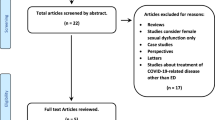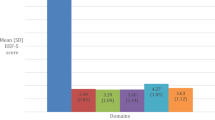Abstract
This study aimed to identify the associated variables of erectile dysfunction (ED) in post myocardial infarction (MI) patients without previous sexual dysfunction (SD). Out of the 37 patients, 15 (40%) had ED. Patients significantly reduced the frequency of coitus (P<0.05). Out of nine patients with distress, eight presented ED, and of 28 patients without distress, seven presented ED (89 versus 25%, P=0.001). The two groups (distress versus without distress) were similar regarding confounding variables. We concluded that patients without SD prior the MI had a significant incidence of ED and distress was an associated variable of ED post-infarction.
This is a preview of subscription content, access via your institution
Access options
Subscribe to this journal
Receive 8 print issues and online access
$259.00 per year
only $32.38 per issue
Buy this article
- Purchase on Springer Link
- Instant access to full article PDF
Prices may be subject to local taxes which are calculated during checkout
Similar content being viewed by others
References
Feldman HA et al. Impotence and its medical and psychosocial correlates: results of the Massachusetts Male Ageing Study. J Urol 1994; 151: 54–61.
Sjögren K, Meyer ARF . Some factors influencing quality of sexual life after myocardial infarction. Int Rehabil Med 1983; 5: 197–201.
Drory Y, Kravetz S, Florian V, Weingarten M . Sexual activity after first acute myocardial infarction in middle-aged men. Cardiology 1998; 90: 207–211.
Pedoe-Tunstall H, Kuulasmaa K, Amouyel P . Myocardial infarction and coronary deaths in the WHO MONICA Project. Circulation 1994; 90: 583–588.
Rosen RC et al. Development and evaluation of an abridged, 5-item version of the International Index of Erectile Function (IIEF-5) as a diagnostic tool for erectile dysfunction. Int J Impot Res 1999; 11: 319–326.
WHO-Division of Mental Health. A user's guide to the self reporting questionnaire (SRQ). Geneva–Switzerland. Draft, 1994, pp 1–64, Electronic Access: http://www.whqlibdoc.who.int/hq/1994/WHO_MNH_PSF_94.8.pdf.
Friedman S . Cardiac disease, anxiety, and sexual functioning. Am J Cardiol 2000; 86(Suppl 2A): 46F–50F.
Goldstein I . The mutually reinforcing triad of depressive symptoms, cardiovascular disease, and erectile dysfunction. Am J Cardiol 2000; 86(Suppl 2A): 41F–45F.
Rampin O, Giuliano F . Central control of the cardiovascular and erection systems: possible mechanisms and interactions. Am J Cardiol 2000; 86: 19F–22F.
Grimm Jr RH et al. Long-term effects on sexual function of five antihypertensive drugs and nutritional hygienic treatment in hypertensive men and women. Treatment of Mild Hypertension Study (TOMHS). Hypertension 1997; 29: 8–14.
Author information
Authors and Affiliations
Corresponding author
Rights and permissions
About this article
Cite this article
Vacanti, L., Caramelli, B. Distress: associated variables of erectile dysfunction post-acute myocardial infarction. A pilot study. Int J Impot Res 17, 204–206 (2005). https://doi.org/10.1038/sj.ijir.3901274
Received:
Revised:
Accepted:
Published:
Issue Date:
DOI: https://doi.org/10.1038/sj.ijir.3901274



